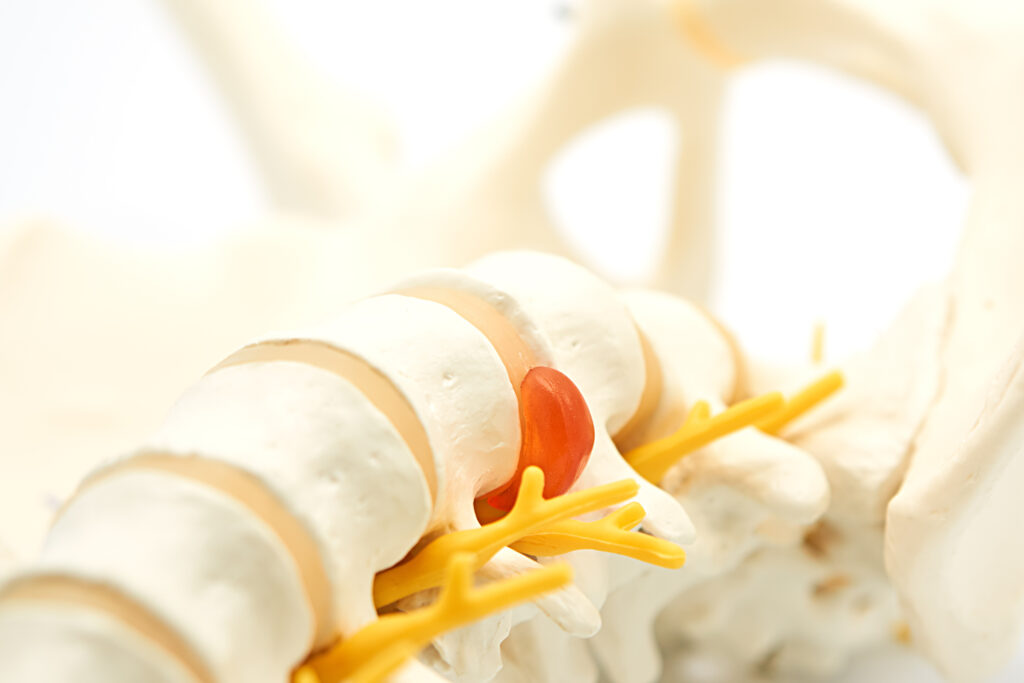What is a herniated disc and how does it develop?
A herniated disc (medical term: disc prolapse) does not usually develop suddenly, but is the result of years of incorrect posture, lack of exercise, and muscular weakness. The intervertebral discs, which act as flexible “shock absorbers” between the vertebrae, become literally “dried out” when there is too little movement and poor posture. They lack the natural supply of nutrients that occurs during phases of pressure and relief when moving.
Without this “pumping action,” the intervertebral discs lose volume and elasticity. The outer fibrous ring can tear, parts of the gelatinous core can protrude and press on nerve roots. The result: severe back pain, numbness, restricted movement, especially in the lumbar spine (L4/L5 or L5/S1).
Herniated disc: Recognizing symptoms and taking the right action
Typical signs:
- Stabbing or pulling pain in the lower back
- Pain radiating to the buttocks or legs (sciatica)
- Tingling, numbness, or muscle weakness in the extremities
- Limitations in mobility and resilience
Important: Not all back pain means a herniated disc. Imaging techniques such as MRI or CT scans provide clarity, but not all protrusions or herniations require surgery.
Conservative therapy: exercise instead of surgery
Modern back training programs and orthopedic guidelines emphasize that exercise is therapy. Targeted back training in particular can:
- activate the deep core muscles
- keep fascia and connective tissue elastic
- stabilize and relieve the spine
- provide lasting pain relief
The following muscles in particular should be trained:
- deep muscles of the spine
- abdominal and back muscles
- gluteal muscles
- hamstring muscles (back of the leg)
Important: Not every type of training is suitable! Specific, individually tailored exercises, such as those used in functional physiotherapy, are more effective than non-specific exercise programs.
New findings from science:
- Movement is the most effective way to supply nutrients to intervertebral discs.
- Even in existing cases, targeted exercises can achieve complete freedom from symptoms.
- Free weight training, when performed correctly, is possible and can provide long-term stabilization.
- Vibration training, coordination, mobilization, and fascia work are now an integral part of modern back therapies.
What you should keep in mind in everyday life
- Avoid sitting for long periods without taking breaks, standing desks, ergonomic seating, and micro-movements can help.
- Learn how to lift and carry correctly, with a straight back and using your legs.
- Incorporate regular exercise, e.g., dynamic walking, cycling, backstroke swimming.
- Avoid monotonous jogging if you are overweight, as high impact can be harmful.
Real-life example: Pain-free thanks to active back training
A former patient with severe protrusion who had been recommended for surgery turned to exercise on the advice of a renowned neurosurgeon. Through targeted back training, coordination and weight training, as well as conscious changes to his everyday routine, he became permanently pain-free despite his initial condition.
Conclusion: Exercise heals—and protects
A herniated disc is not fate, but a wake-up call. Those who take action in time can avoid surgery, relieve pain, and significantly improve their quality of life.
Frequently asked questions about herniated discs
What is the difference between disc protrusion and disc prolapse?
A protrusion is a slight displacement of the disc without a tear. In a prolapse, disc tissue protrudes, usually with more severe symptoms.
Does a herniated disc always require surgery?
No. In over 85% of cases, conservative therapy with exercise, physical therapy, and muscle building is successful.
Is exercise dangerous for herniated discs?
Not if it is done correctly! Special back training stabilizes the spine and supports the healing process.
Which sports are back-friendly?
Backstroke swimming, walking, functional training, yoga, and guided strength training are considered particularly spine-friendly.
What helps against back pain in the long term?
Active prevention through training, ergonomic behavior in everyday life, and stress management—because psychological factors also play a role. soulboxer🥊🙏❤️
